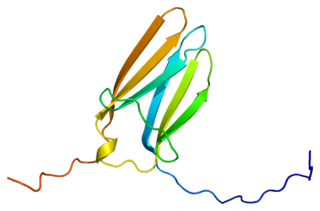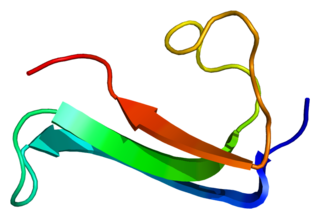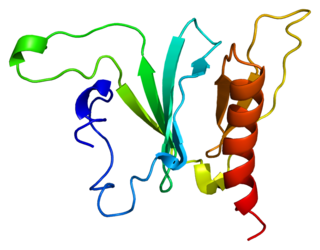Anaplastic lymphoma kinase (ALK) also known as ALK tyrosine kinase receptor or CD246 (cluster of differentiation 246) is an enzyme that in humans is encoded by the ALK gene. [5] [6]
Anaplastic lymphoma kinase (ALK) also known as ALK tyrosine kinase receptor or CD246 (cluster of differentiation 246) is an enzyme that in humans is encoded by the ALK gene. [5] [6]
Anaplastic lymphoma kinase (ALK) was originally discovered in 1994 [5] [7] in anaplastic large-cell lymphoma (ALCL) cells. ALCL is caused by a (2;5)(p23:q35) chromosomal translocation that generates the fusion protein NPM-ALK, in which the kinase domain of ALK is fused to the amino-terminal part of the nucleophosmin (NPM) protein. Dimerization of NPM constitutively activates the ALK kinase domain. [5] [7]
The full-length protein ALK was identified in 1997 by two groups. [8] [9] The deduced amino acid sequences revealed that ALK was a novel receptor tyrosine kinase (RTK), having an extracellular ligand-binding domain, a transmembrane domain, and an intracellular tyrosine kinase domain. [8] [9] While the tyrosine kinase domain of human ALK shares a high degree of similarity with that of the insulin receptor, its extracellular domain is unique among the RTK family in containing two MAM domains (meprin, A5 protein and receptor protein tyrosine phosphatase mu), an LDLa domain (low-density lipoprotein receptor class A) and a glycine-rich region. [9] [10] Based on overall homology, ALK is closely related to the leukocyte receptor tyrosine kinase (LTK) and, together with the insulin receptor, forms a subgroup in the RTK superfamily. [8] [9] The human ALK gene encodes a protein 1,620 amino acids long with a molecular weight of 180 kDa. [8] [9]
Since the original discovery of the receptor in mammals, several orthologs of ALK have been identified: dAlk in the fruit fly ( Drosophila melanogaster ) in 2001, [10] scd-2 in the nematode ( Caenorhabditis elegans ) in 2004, [11] and DrAlk in the zebrafish ( Danio rerio ) in 2013. [12]
The ligands of the human ALK/LTK receptors were identified in 2014: [13] [14] [15] FAM150A (AUGβ) and FAM150B (AUGα), two small secreted peptides that strongly activate ALK signaling. In invertebrates, ALK-activating ligands are Jelly belly (Jeb) in Drosophila, [16] [17] and hesitation behaviour 1 (HEN-1) in C. elegans. [18] No such ligands have been reported yet in zebrafish or other vertebrates. [19]
Following binding of the ligand, the full-length receptor ALK dimerizes, changes conformation, and autoactivates its own kinase domain, which in turn phosphorylates other ALK receptors in trans on specific tyrosine amino acid residues. ALK phosphorylated residues serve as binding sites for the recruitment of several adaptor and other cellular proteins, such as GRB2, [20] IRS1, [20] [21] Shc, [20] [22] Src, [23] FRS2, [22] PTPN11/Shp2, [24] PLCγ, [25] [21] PI3K, [26] [21] and NF1. [27] Other reported downstream ALK targets include FOXO3a, [28] CDKN1B/p27kip, [29] cyclin D2, NIPA, [30] [31] RAC1, [32] CDC42, [33] p130CAS, [34] SHP1, [35] and PIKFYVE. [36]
Phosphorylated ALK activates multiple downstream signal transduction pathways, including MAPK-ERK, PI3K-AKT, PLCγ, CRKL-C3G, and JAK-STAT. [37] [19]
The receptor ALK plays a pivotal role in cellular communication and in the normal development and function of the nervous system. [6] This observation is based on the extensive expression of ALK messenger RNA (mRNA) throughout the nervous system during mouse embryogenesis. [8] [9] [38] In vitro functional studies have demonstrated that ALK activation promotes neuronal differentiation of PC12 [39] [40] [41] [22] or neuroblastoma cell lines. [21]
ALK is critical for embryonic development in Drosophila . Flies lacking the receptor die due to failure of founder cell specification in embryonic visceral muscle. [16] [17] [42] However, while ALK knockout mice exhibit defects in neurogenesis and testosterone production, they remain viable, suggesting that ALK is not critical to their developmental processes. [43] [44] [45]
ALK regulates retinal axon targeting, [46] growth and size, [27] [47] synapse development [11] at the neuromuscular junction, [48] [49] behavioral responses to ethanol, [50] [51] [52] [53] and sleep. [54] It restricts and constrains learning and long-term memory [27] [55] [44] and small-molecule inhibitors of the ALK receptor can improve learning, [27] long-term memory, [55] and extend healthy lifespan. [56] ALK is also a candidate thinness gene, as its genetic deletion leads to resistance to diet- and leptin-mutation-induced obesity. [57] [N 1]
The ALK gene can be oncogenic in three ways – by forming a fusion gene with any of several other genes, by gaining additional gene copies or with mutations of the actual DNA code for the gene itself. [37] [19]
The 2;5 chromosomal translocation is associated with approximately 60% of anaplastic large-cell lymphomas (ALCLs), type ALK-positive anaplastic large cell lymphoma and very rare cases of ALCL type primary cutaneous anaplastic large cell lymphoma. The translocation creates a fusion gene consisting of the ALK (anaplastic lymphoma kinase) gene and the nucleophosmin (NPM) gene: the 3' half of ALK, derived from chromosome 2 and coding for the catalytic domain, is fused to the 5' portion of NPM from chromosome 5. The product of the NPM-ALK fusion gene is oncogenic. In a smaller fraction of ALCL patients, the 3' half of ALK is fused to the 5' sequence of TPM3 gene, encoding for tropomyosin 3. In rare cases, ALK is fused to other 5' fusion partners, such as TFG, ATIC, CLTC1, TPM4, MSN, ALO17, MYH9. [58]
The EML4-ALK fusion gene is responsible for approximately 3-5% of non-small-cell lung cancer (NSCLC). The vast majority of cases are adenocarcinomas. [59] Patients with this ALK rearrangement have the following clinicopathologic characteristics: Young age at diagnosis (median 50 years), female gender, nonsmoker/light smoker, adenocarcinoma histology with specific morphologic patterns such as cribriform and solid signet ring, expression of thyroid transcription factor 1, tendency to metastasize to pleura or pericardium, frequently with more metastases than other molecular types, and predominantly metastases to the central nervous system. [60] The standard test used to detect this gene in tumor samples is fluorescence in situ hybridization (FISH) by a US FDA approved kit. Recently Roche Ventana obtained approval in China and European Union countries to test this mutation by immunohistochemistry. [59] Other techniques like reverse-transcriptase PCR (RT-PCR) can also be used to detect lung cancers with an ALK gene fusion but not recommended.[ citation needed ] ALK lung cancers are found in patients of all ages, although on average these patients tend to be younger. ALK lung cancers are more common in light cigarette smokers or nonsmokers, but a significant number of patients with this disease are current or former cigarette smokers. EML4-ALK-rearrangement in NSCLC is exclusive and not found in EGFR- or KRAS-mutated tumors. [61]
In patients affected by relapsed or refractory ALK+ Anaplastic Large Cell Lymphoma, crizotinib produced objective response rates ranging from 65% to 90% and 3 year progression free survival rates of 60-75%. No relapse of the lymphoma was ever observed after the initial 100 days of treatment. Treatment must be continued indefinitely at present. [77] [78] [79]

A tyrosine kinase is an enzyme that can transfer a phosphate group from ATP to the tyrosine residues of specific proteins inside a cell. It functions as an "on" or "off" switch in many cellular functions.

Keratin, type II cytoskeletal 7 also known as cytokeratin-7 (CK-7) or keratin-7 (K7) or sarcolectin (SCL) is a protein that in humans is encoded by the KRT7 gene. Keratin 7 is a type II keratin. It is specifically expressed in the simple epithelia lining the cavities of the internal organs and in the gland ducts and blood vessels.

Anaplastic large-cell lymphoma (ALCL) refers to a group of non-Hodgkin lymphomas in which aberrant T cells proliferate uncontrollably. Considered as a single entity, ALCL is the most common type of peripheral lymphoma and represents ~10% of all peripheral lymphomas in children. The incidence of ALCL is estimated to be 0.25 cases per 100,000 people in the United States of America. There are four distinct types of anaplastic large-cell lymphomas that on microscopic examination share certain key histopathological features and tumor marker proteins. However, the four types have very different clinical presentations, gene abnormalities, prognoses, and/or treatments.

Tropomyosin receptor kinase C (TrkC), also known as NT-3 growth factor receptor, neurotrophic tyrosine kinase receptor type 3, or TrkC tyrosine kinase is a protein that in humans is encoded by the NTRK3 gene.

Midkine, also known as neurite growth-promoting factor 2 (NEGF2), is a protein that in humans is encoded by the MDK gene.

Proto-oncogene c-KIT is the gene encoding the receptor tyrosine kinase protein known as tyrosine-protein kinase KIT, CD117 or mast/stem cell growth factor receptor (SCFR). Multiple transcript variants encoding different isoforms have been found for this gene. KIT was first described by the German biochemist Axel Ullrich in 1987 as the cellular homolog of the feline sarcoma viral oncogene v-kit.

Son of sevenless homolog 1 is a protein that in humans is encoded by the SOS1 gene.

The RETproto-oncogene encodes a receptor tyrosine kinase for members of the glial cell line-derived neurotrophic factor (GDNF) family of extracellular signalling molecules. RET loss of function mutations are associated with the development of Hirschsprung's disease, while gain of function mutations are associated with the development of various types of human cancer, including medullary thyroid carcinoma, multiple endocrine neoplasias type 2A and 2B, pheochromocytoma and parathyroid hyperplasia.

Fibroblast growth factor receptor 1 (FGFR1), also known as basic fibroblast growth factor receptor 1, fms-related tyrosine kinase-2 / Pfeiffer syndrome, and CD331, is a receptor tyrosine kinase whose ligands are specific members of the fibroblast growth factor family. FGFR1 has been shown to be associated with Pfeiffer syndrome, and clonal eosinophilias.

ETV6 protein is a transcription factor that in humans is encoded by the ETV6 gene. The ETV6 protein regulates the development and growth of diverse cell types, particularly those of hematological tissues. However, its gene, ETV6 frequently suffers various mutations that lead to an array of potentially lethal cancers, i.e., ETV6 is a clinically significant proto-oncogene in that it can fuse with other genes to drive the development and/or progression of certain cancers. However, ETV6 is also an anti-oncogene or tumor suppressor gene in that mutations in it that encode for a truncated and therefore inactive protein are also associated with certain types of cancers.

Protein TFG is a protein that in humans is encoded by the TFG gene.

Factor interacting with PAPOLA and CPSF1 is a protein that in humans is encoded by the FIP1L1 gene. A medically important aspect of the FIP1L1 gene is its fusion with other genes to form fusion genes which cause clonal hypereosinophilia and leukemic diseases in humans.

Proto-oncogene tyrosine-protein kinase ROS is an enzyme that in humans is encoded by the ROS1 gene.

Platelet-derived growth factor receptor A, also termed CD140a, is a receptor located on the surface of a wide range of cell types. The protein is encoded in the human by the PDGFRA gene. This receptor binds to certain isoforms of platelet-derived growth factors (PDGFs) and thereby becomes active in stimulating cell signaling pathways that elicit responses such as cellular growth and differentiation. The receptor is critical for the embryonic development of certain tissues and organs, and for their maintenance, particularly hematologic tissues, throughout life. Mutations in PDGFRA, are associated with an array of clinically significant neoplasms, notably ones of the clonal hypereosinophilia class of malignancies, as well as gastrointestinal stromal tumors (GISTs).

Crizotinib, sold under the brand name Xalkori among others, is an anti-cancer medication used for the treatment of non-small cell lung carcinoma (NSCLC). It acts as an ALK and ROS1 inhibitor.

ALK inhibitors are anti-cancer drugs that act on tumours with variations of anaplastic lymphoma kinase (ALK) such as an EML4-ALK translocation. They fall under the category of tyrosine kinase inhibitors, which work by inhibiting proteins involved in the abnormal growth of tumour cells. All the current approved ALK inhibitors function by binding to the ATP pocket of the abnormal ALK protein, blocking its access to energy and deactivating it. A majority of ALK-rearranged NSCLC harbour the EML4-ALK fusion, although as of 2020, over 92 fusion partners have been discovered in ALK+ NSCLC. For each fusion partner, there can be several fusion variants depending on the position the two genes were fused at, and this may have implications on the response of the tumour and prognosis of the patient.

ALK positive lung cancer is a primary malignant lung tumor whose cells contain a characteristic abnormal configuration of DNA wherein, most frequently, the echinoderm microtubule-associated protein-like 4 (EML4) gene is fused to the anaplastic lymphoma kinase (ALK) gene. Less frequently, there will be novel translocation partners for the ALK gene, in place of EML4. This abnormal gene fusion leads to the production of a protein that appears, in many cases, to promote and maintain the malignant behavior of the cancer cells.

Inflammatory myofibroblastic tumor (IMT) is a rare neoplasm of the mesodermal cells that form the connective tissues which support virtually all of the organs and tissues of the body. IMT was formerly termed inflammatory pseudotumor. Currently, however, inflammatory pseudotumor designates a large and heterogeneous group of soft tissue tumors that includes inflammatory myofibroblastic tumor, plasma cell granuloma, xanthomatous pseudotumor, solitary mast cell granuloma, inflammatory fibrosarcoma, pseudosarcomatous myofibroblastic proliferation, myofibroblastoma, inflammatory myofibrohistiocytic proliferation, and other tumors that develop from connective tissue cells. Inflammatory pseudotumour is a generic term applied to various neoplastic and non-neoplastic tissue lesions which share a common microscopic appearance consisting of spindle cells and a prominent presence of the white blood cells that populate chronic or, less commonly, acute inflamed tissues.
ALK+ large B-cell lymphoma is a type of lymphoma. It was first reported in 1997. It is a rare, aggressive large B-cell process that shows ALK expression. It is distinct from anaplastic large cell lymphoma, a T-cell lymphoma.

Entrectinib, sold under the brand name Rozlytrek, is an anti-cancer medication used to treat ROS1-positive non-small cell lung cancer and NTRK fusion-positive solid tumors. It is a selective tyrosine kinase inhibitor (TKI), of the tropomyosin receptor kinases (TRK) A, B and C, C-ros oncogene 1 (ROS1) and anaplastic lymphoma kinase (ALK).
This article incorporates text from the United States National Library of Medicine, which is in the public domain.